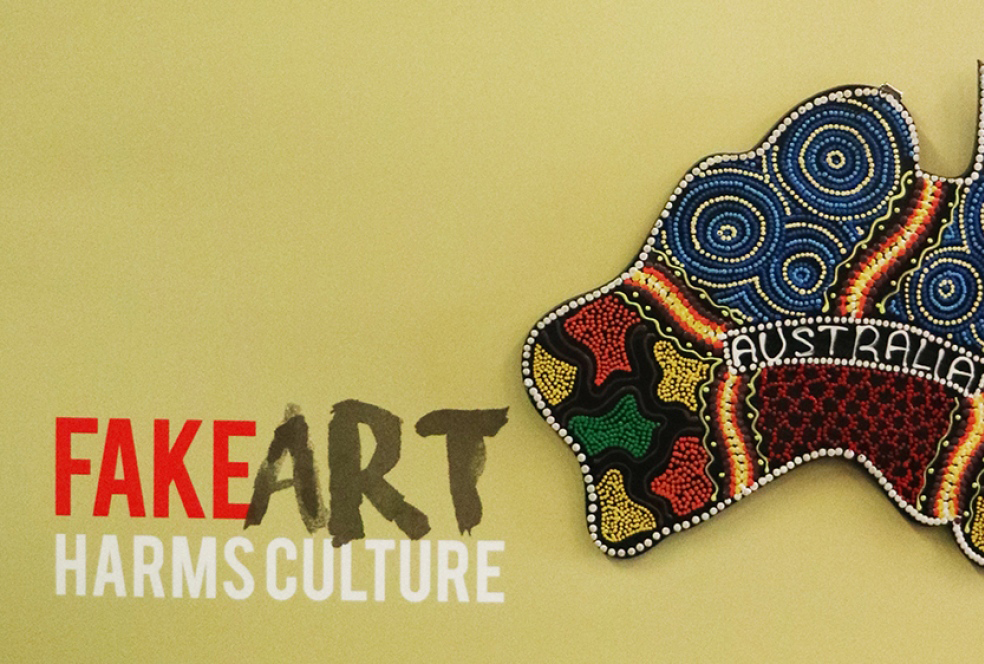Fake Art Harms Culture – updates and the National Indigenous Visual Art Action Plan

Since 2016, following representations by Aboriginal and Torres Strait Islander community members and artists, key peak bodies, the Arts Law Centre of Australia, Indigenous Art Code and Copyright Agency began to explore how to best respond to concerns about the growing presence of inauthentic ‘Aboriginal style’ art and craft products and merchandise for sale across Australia. We refer to this campaign as the ‘Fake Art Harms Culture’ campaign.
Since we launched the Fake Art Harms Culture campaign in 2016, Arts Law has worked hard to call for Government to tackle the problem of fake ‘Indigenous’ arts and craft being sold in Australia, to prevent harm to Aboriginal and Torres Strait Islander artists and communities. You can read more about the progress of the Fake Art Harms Culture campaign on Arts Law’s website here.
Despite us still waiting for a commitment to a change to the laws, we are pleased to see there has been some recent progress with the Australian Government leading an inquiry into the issue and also the release of a National Indigenous Visual Arts Action Plan for 2021-25.
The Australian Government Productivity Commission Inquiry into Aboriginal and Torres Strait Islander visual arts and crafts
On 21 September 2021, the Productivity Commission released an Issues Paper and opened submissions for its study into Aboriginal and Torres Strait Islander Visual Arts and Crafts. The deadline for these submissions is Monday 13 December 2021 and further information can be viewed on the Australian Government’s website here. The Productivity Commission has been asked to examine the value, nature and structure of markets for Aboriginal and Torres Strait Islander arts and crafts, and develop policies to address deficiencies in these markets.
Arts Law has been consulting with the Commission on the Issues Paper and will be making a submission to highlight unfair and exploitative practices in Indigenous art markets, and the need for better legal protections for Indigenous Cultural and Intellectual Property.
We encourage all stakeholders to make submissions to this inquiry. The Commission is accepting video submissions, or brief comments from people and organisations, so you don’t necessarily need to commit to writing a lengthy submission. Your voice is important!
If you would like to draw from some of the concerns and recommendations Arts Law has identified, you can view submissions Arts Law has previously made to the Government on this topic:
- IP Australia Indigenous Knowledge Consultation, 14 June 2012
- Arts Law Centre of Australia, Copyright Agency and Indigenous Art Code, Submission to the Committee Inquiry – Competition and Consumer Amendment (Prevention of Exploitation of Indigenous Cultural Expression) Bill 2019)
- Arts Law Centre of Australia, Submission 64, The Growing Presence of Inauthentic Aboriginal and Torres Strait Islander ‘Style’ Art and Craft Products and Mechandise for Sale Across Australia, 3 November 2017; amended 11 May 2018
The Australian Government has released a plan to support Aboriginal and Torres Strait Islander artists, organisations and businesses
On Thursday 21 October, the Minister for Communications, Urban Infrastructure, Cities and the Arts of Australia, Paul Fletcher and the Minister for Indigenous Australians, Ken Wyatt released the National Indigenous Visual Art Action Plan 2021-25.
The Fake Art Harms Culture campaign is credited in the plan with highlighting the prevalence of inauthentic arts and crafts products for sale in Australia and bringing these issues to the attention of Government. This is a huge success for the Fake Art Harms Culture campaign.
Key actions that the Government intends to take as outlined in the plan include:
- Working with Indigenous communities to find out whether a certification trademark or a separate law on Indigenous cultural intellectual protection would provide better protections for Indigenous artists and designers.
- Encouraging an ethical marketplace by supporting the Indigenous art code and assessing the work it does to help Indigenous artists.
- Promoting of the importance of ethical and authentic Aboriginal and Torres Strait Islander artworks to consumers.
We think that the initiatives outlined in the plan are a great step towards legal protections for culture and we’re looking forward to seeing how these will be implemented.
Arts Law is continuing our work in protecting culture by helping Aboriginal and Torres Strait Islander artists through our Artists in the Black service. Some examples of the recent work we have been doing to assist artists include:
- ‘Licensing the Right Way’ program– helping review and to draft contracts for artists to ensure they are entering into fair deals
- Education and seminars – continuing to increase awareness around legal issues and empowering artists to protect their rights
- Wills project – helping artists to put wills in place to protect their estate and ensure that their copyright is dealt with in accordance with their wishes after they pass away.

